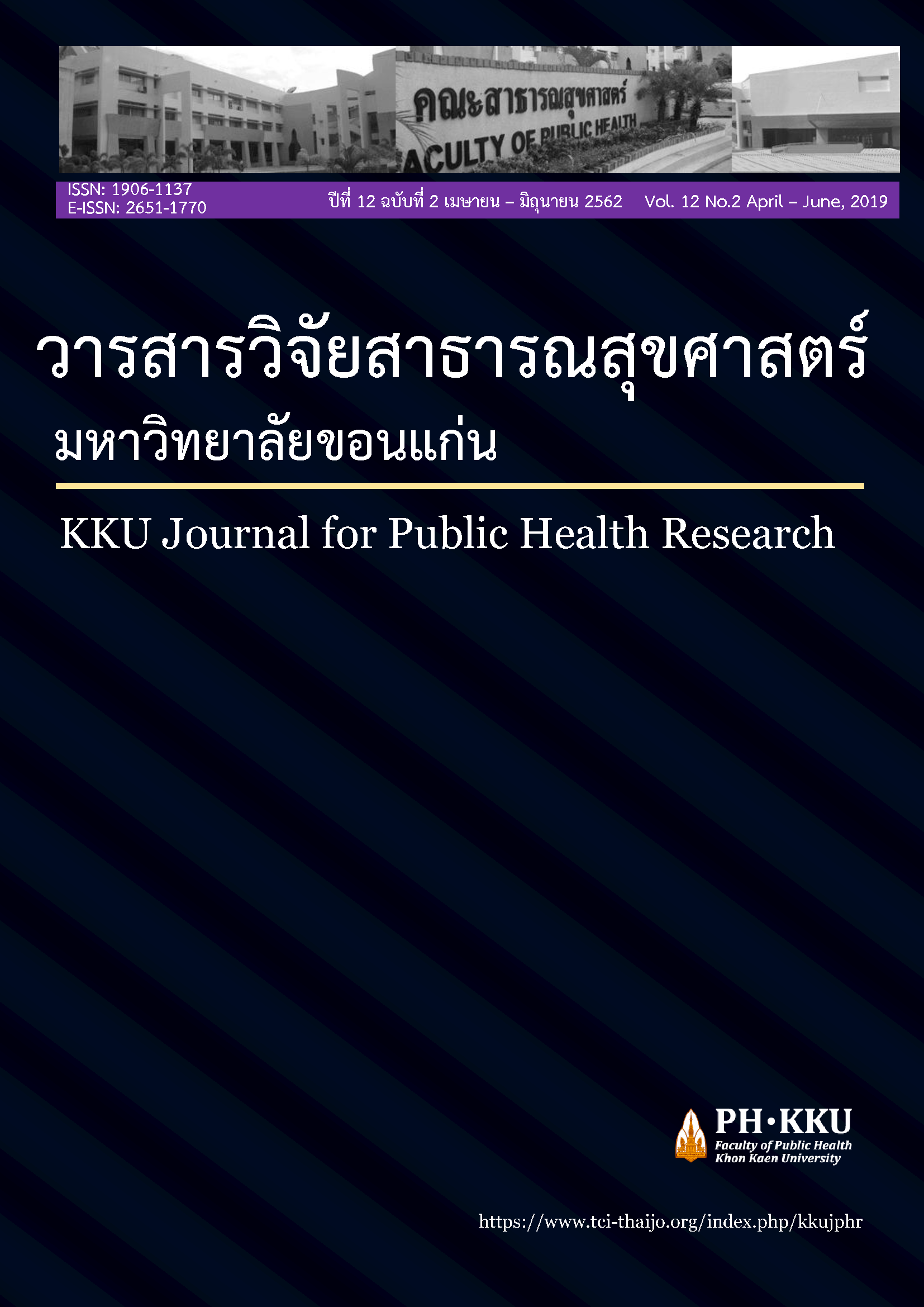Stress and Anxiety During the Waiting Period for Colonoscopy
-
Keywords:
Anxiety, Stress, Colorectal CancerAbstract
Waiting for a colonoscopy to confirm if the cancer is exited can cause anxiety and stress. This cross-sectional analytic study aimed to investigate the factors related to the anxiety and stress levels which occur during the waiting period for colonoscopy. The study was conducted on the participants in the colorectal cancer screening research project. The project was an experimental research study that had been carried out at the community level in the Nampong District of Khon Kaen Province. The cases for the study were 92 participants who had received a positive result on the Fecal Immunochemical Test (iFOBT). The data was collected through interviews and was analyzed for descriptive statistics.Multiple logistic regression analysis (significance level=0.05) was employed to reveal the inferential statistics.
According to the results of the study factors related to the anxiety were those aged less than 60 years (ORadj=8.12; 95% CI=2.46-26.85; p-value=0.001), and the marital status single/divorce/separate (ORadj =49.05; 95% CI=5.15–467.59; p-value= 0.001). Factors related to the stress were those aged less than 60 years (95% CI=1.21-9.41; p-value=0.020), and the length of the waiting time from being made aware of a positive iFOBT result to the completion of the colonoscopy who had been aware of the positive result for less than 2 months (ORadj =9.83; 95% CI=3.22–30.01; p-value<0.001).
Public Health personnel should, therefore, determine approaches which can be used to reduce anxiety and stress in the participants, especially those: 1) are younger than 60 years old, 2) are single/divorce/separate, and have been waiting for less than 2 months. Moreover, the participants should be clearly informed of the colonoscopy process, and the participants’ anxiety and stress levels should be evaluated and monitored. Finally, to relieve their anxiety and stress, the idea of encouraging the participants should be promoted.
References
กรมสุขภาพจิต กระทรวงสาธารณสุข. (2541). การพัฒนาแบบประเมินและการวิเคราะห์ความเครียดด้วยตนเองสำหรับประชาชนไทย. นนทบุรี: กระทรวงสาธารณสุข.
จีรวรรณ จบสุบิน. (2551). ความชุกภาวะวิตกกังวล ภาวะซึมเศร้าและปัจจัยที่เกี่ยวข้องในผู้ป่วยมะเร็งเต้านมที่ได้รับยาเคมีบำบัด ณ โรงพยาบาลจุฬาลงกรณ์. วิทยานิพนธ์ปริญญาวิทยาศาสตรมหาบัณฑิต สาขาวิชาสุขภาพจิต บัณฑิตวิทยาลัย จุฬาลงกรณ์มหาวิทยาลัย.
ประกายทิพย์ ศิริวงศ์, พัชนี ศรีสวัสดิ์, & ปรมาภรณ์ ปราสาททองโอสถ. (2552). การศึกษาความเครียดและเผชิญความเครียดของผู้ป่วยมะเร็งเต้านมก่อนผ่าตัด. วารสารพยาบาลศิริราช, 3(1), 1-14.
พรทิวา มีสุวรรณ, & ขนิษฐา นาคะ. (2551). การรับรู้ความรุนแรงของการเจ็บป่วย ความต้องการข้อมูล และความวิตกกังวลของผู้ป่วยก่อนได้รับการผ่าตัดหู คอ จมูก ในโรงพยาบาลสงขลานครินทร์. สงขลานครินทร์เวชสาร, 26(2), 185-194.
ศุภกาญจน์ โอภาสรัตนากร. (2558). ความเครียดและการเผชิญความเครียดของผู้ป่วยโรคมะเร็งหลังโพรงจมูกที่ได้รับการรักษาด้วยการฉายรังสีร่วมกับยาเคมีบำบัด. รามาธิบดีพยาบาลสาร, 21(2), 158-171.
สมภพ เรืองตระกูล. (2551). ความเครียดและการตอบสนองของภูมิคุ้มกันในโรคมะเร็ง อาการทางจิตเวชและการรักษา. กรุงเทพฯ: เรือนแก้วการพิมพ์.
สุนีย์ จันทร์มหเสถียร, & นันทา เล็กสวัสดิ์. (2549). ความวิตกกังวลก่อนผ่าตัดใน ผู้ป่วยที่ได้รับการผ่าตัดใหญ่. พยาบาลสาร, 33(2), 184-194.
เอื้องพร พิทักษ์สังข์. (2554). ความวิตกกังวล ความเครียดและความต้องการข้อมูลของผู้ป่วยก่อนได้รับการผ่าตัดทางตาแบบผู้ป่วยนอก. พยาบาลศิริราช, 4(1), 35-42.
Bessissow, T., Van Keerberghen, C. A., Van Oudenhove, L., Ferrante, M., Vermeire, S., Rutgeerts, P., et al. (2013). Anxiety is associated with impaired tolerance of colonoscopy preparation in inflammatory bowel disease and controls. Journal of Crohn's and Colitis, 7(11). 580-587.
Chen, L. S., Liao, C. S., Chang, S. H., Lai, H. C., & Chen, T. H. (2007). Cost-effectiveness analysis for determining optimal cut-off of immunochemical faecal occult blood test for population-based colorectal cancer screening. Journal of Medical Screening, 14(4), 191-199.
Chung, Y. W., Han, D. S., Yoo, K. S., & Park, C. K. (2007). Patient factors predictive of pain and difficulty during sedation-free colonoscopy: A prospective study in Korea. Digestive and Liver Disease, 39(9), 872-876.
Fabrizio, S., Manuel, Z., & Grazia, G .(2014). Colorectal cancer screening: Tests, strategies, and perspectives. Frontiers in public health, 2, 210.
Grazzini, G., Ciatto, S., Cislaghi, C., Castiglione, G., Falcone, M., Mantellini, P., & Zappa, M. (2008). Cost evaluation in a colorectal cancer screening programme by faecal occult blood test in the District of Florence. Journal of Medical Screening, 15(4), 175-181.
Hsieh, F. Y., Bloch, D. A., & Larsen, M. D. (1998). A simple method of sample size calculation for linear and logistic regression. Statistics in Medicine, 17(14), 1623-1634.
International Agency for Research on Cancer, World Health Organization. (2012). Globocan: Estimated cancer incidence, mortality and prevalence worldwide in 2012. Retrieved August 10, 2016, from http://globocan.iarc.fr/Default.aspx
Lohsiriwat, V., Lohsiriwat, D., Chinswangwatanakul, V., Akaraviputh, T., & Lert-Akyamanee, N. (2007). Comparison of short-term outcomes between laparoscopically-assisted vs. transverse-incision open right hemicolectomy for right-sided colon cancer: A retrospective study. World Journal of Surgical Oncology, 11(5), 49.
Pongnikorn, D., Suwanrungruang, K., & Buasom, R. (2015). Cancer Incidence in Thailand. In W. Imsamran, A. Chaiwerawattana, S. Wiangnon, D. Pongnikorn, K. Suwanrungrung, S. Sangrajrang, et al. (Eds.). Cancer in Thailand: Vol. VIII, 2010–2012. (pp. 5-31). Bangkok: National Cancer Institute Thailand.
Spielberger, D., Gorsuch, L., Lushene, R., Vagg, R., & Jacobs, A. (1983). Manual for the state-trait anxiety inventory. Palo Alto, CA: Consulting Psychologists Press.



